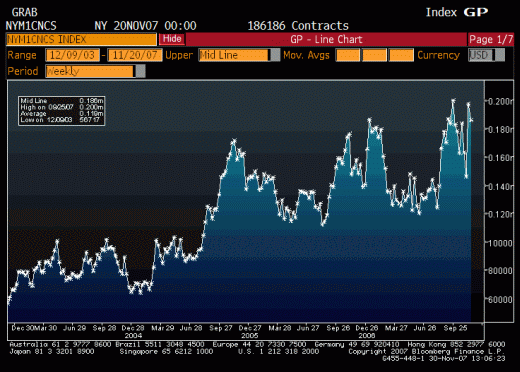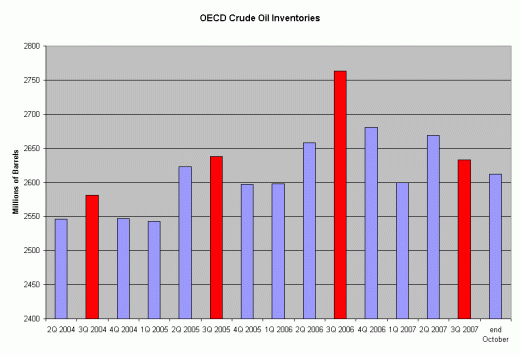Crude Oil Headed Down to $70 For Historic Buying Opportunity
Commodities / Crude Oil Dec 03, 2007 - 12:10 AM GMTBy: Elliot_H_Gue

 For the first time in more than a year, I'm a near-term bear on oil prices. I suspect that crude could fall to around $70 per barrel in the next three to four months, roughly a 30 percent correction from its recent highs. This move will be a correction of the long-term uptrend in crude, not the end of the bull market. This correction will mark a historic buying opportunity for both oil and oil-related stocks.
For the first time in more than a year, I'm a near-term bear on oil prices. I suspect that crude could fall to around $70 per barrel in the next three to four months, roughly a 30 percent correction from its recent highs. This move will be a correction of the long-term uptrend in crude, not the end of the bull market. This correction will mark a historic buying opportunity for both oil and oil-related stocks.
I posted a comment and video clip on At These Levels ( www.attheselevels.com ) earlier this week that explains the rationale behind that short-term bearish take. To elaborate further, crude oil's rise to near $100 a barrel has been widely reported in the print and television media; these outlets have offered myriad “explanations” for the rally. But the fact is that most of these explanations are totally and completely wrong.
Many investors and pundits remain wedded to the idea that crude oil's rise is some sort of speculative bubble or temporary spike. Therefore, explanations for the rally tend to center around minor, short-term factors rather than the explosively bullish longer-term supply and demand picture. One of the most-often mentioned explanations for oil's rally is that it's a function of speculative buying of oil futures. Fortunately, we can debunk that idea simply by looking at the Commitment of Traders (COT) Report released weekly by the Commodity Futures Trading Commission (CFTC).
Basically, the COT breaks down futures traders into two groups: commercials and non-commercials. Commercials would be companies using futures to hedge their business risks. Examples might include a refiner looking to hedge against the potential for crude oil prices to rise or an oil producer using futures to lock in attractive prices for their production. Commercials aren't really speculating on the futures market.
The non-commercials are traders. These would include hedge funds making a bet on the future direction of prices. Non-commercials are a decent gauge of sentiment. When these traders are heavily net long it can mean that there are few marginal buyers left to push prices higher. Sometimes, this can mark a short-term top.
Typically, when the media states that high oil prices are a function of speculation, they'll present a chart that looks like the one below.

Source: Bloomberg
This chart shows total non-commercial long commitments in the futures market. Obviously, this line is rising, meaning that more speculative traders are buying oil futures, betting on a rise in prices. This is often presented as a sign of excess speculation.
But this is only half the story. Check out my chart below.

Source: Bloomberg
This chart shows total short commitments by non-commercial traders. These are speculators betting on a fall in oil prices. Note that this line is also rising. If we look at this chart in isolation, it might suggest that non-commercials are actually overly bearish oil prices.
The fact is we have to consider both charts to get the complete picture. The fact is that traders have been getting more bullish on oil as the commodity has risen in the past 12 months. However, sentiment isn't at all as bullish as my chart of long commitments suggests. The fact is that total open interest—long and short—has been rising this year. If we consider long-side interest as a percent of total open interest, the chimera of a speculative futures bubble in oil disappears.
The reason for oil's rally has to do with simple supply and demand. Inventories of oil and refined products in the developed countries have been falling during a time of year when they normally build. Meanwhile, demand for oil has remained firm despite relatively high prices. Check out the chart below.

Source: International Energy Agency
There are a few key points to note about this chart. The first is that I've labeled the third quarter of each year as a red bar.
Note that at the end of the third quarter, OECD inventories of crude were considerably lower than a year ago and actually lower than in 2005. Therefore, across the OECD, the supply of crude is tighter than it has been at this time of year since 2004.
Also note the typical change in OECD inventories between the second quarter and third quarter of each year. In a normal year, crude oil stocks actually rise between the end of the second quarter and the end of the third quarter. This corresponds to the end of the summer driving season in the Northern Hemisphere.
Note, however, that there was actually a fall in OECD crude oil inventories in the third quarter this year. Stocks of crude fell approximately 360,000 barrels per day in the fourth quarter, a counter-seasonal crude oil drawdown. That continued into October; early International Energy Agency (IEA) estimates show a further 21-million-barrel draw in the month for OECD countries.
Although US oil inventories remain above average for this time of year, inventories did decline in the third quarter. That's certainly not the normal seasonal pattern. And we can't focus solely on the US; oil inventories in Japan, for example, currently stand at their lowest level in at least 20 years.
But this picture is about to change. The reason is that until very recently, OPEC has remained disciplined and hasn't been sending as much oil to the West as it normally would at this time of the year. This is evident from the fact that tanker rates have remained depressed at a time of year when they normally rise. Those ships are sitting idle because OPEC isn't shipping oil. With OPEC not shipping and oil production from non-OPEC countries weaker-than-expected, global oil inventories fell sharply.
But tanker rates are now spiking higher to the highest levels since mid-2006. That suggests that OPEC is now shipping oil west. As this oil hits the inventory numbers sometime in the first quarter of next year, the supply picture will look far looser.
Keep in mind this is a short-term phenomenon. Longer term, demand from the developing world will continue to rise. And supplies will continue to be challenged. Global oil supplies simply aren't keeping pace with growth in demand.
By Elliott H. Gue
The Energy Letter
© 2007 Elliott H. Gue
Elliott H. Gue is editor of The Energy Letter , a bi-weekly e-letter as well as editor of The Energy Strategist , a premium bi-weekly newsletter on the energy markets. Mr. Gue is also associate editor for Personal Finance , where he contributes his knowledge of the energy markets.
Mr. Gue has a Master's of Finance degree from the University of London and a Bachelor of Science degree in Economics and Management from the University of London , graduating in the top 3 percent of his class. Mr. Gue was the first American student to ever complete a full degree at that university.
Elliott H. Gue Archive |
© 2005-2022 http://www.MarketOracle.co.uk - The Market Oracle is a FREE Daily Financial Markets Analysis & Forecasting online publication.


